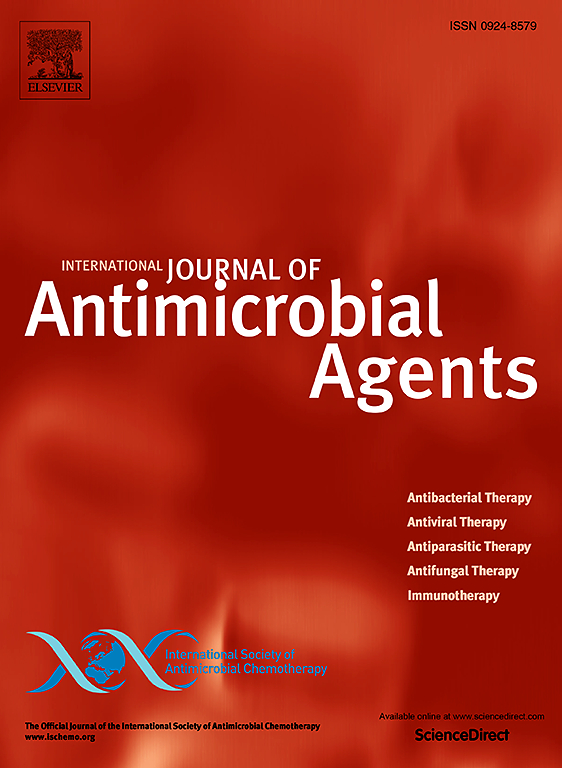LuxS/AI-2 system facilitates the dissemination of antibiotic-resistant plasmids in Klebsiella pneumoniae
IF 4.9
2区 医学
Q1 INFECTIOUS DISEASES
International Journal of Antimicrobial Agents
Pub Date : 2024-10-23
DOI:10.1016/j.ijantimicag.2024.107361
引用次数: 0
Abstract
Plasmid conjugation is a central mechanism driving the dissemination of antibiotic resistance in Klebsiella pneumoniae. However, the conjugative operon requires specific stimuli for activation. Identifying signals and elucidating the underlying mechanisms is crucial in combating plasmid spread. This study uncovers a key mechanism promoting the dissemination of high-risk plasmids, including IncFII, IncX3, and IncX4 types, in K. pneumoniae. In this study, increased donor density significantly enhanced conjugation, and transcript levels of both conjugation and AI-2 quorum sensing genes were markedly upregulated. Mutating the luxS and lsrR genes in K. pneumoniae 1678 decreased plasmid conjugation efficiency in the 1678ΔluxS mutant, and significantly increased plasmid conjugation efficiency in the 1678ΔlsrR mutant. RT-qPCR and β-galactosidase assays showed that LsrR represses transcription of relaxosome and T4CP genes, whereas AI-2 (synthesised by LuxS) activates their expression. AlphaFold 3 docking models indicate that LsrR may bind directly to IncX plasmid relaxase promoters, inhibiting their expression. Adding external AI-2 signals revealed no effect on plasmid conjugation when LsrR was absent, confirming the dependence of AI-2 signals on LsrR repression. In conclusion, AI-2-mediated signalling enhances donor density effects on plasmid conjugation by de-repressing LsrR-mediated suppression.
LuxS/AI-2 系统有助于肺炎克雷伯氏菌中抗生素质粒的传播。
质粒共轭是推动肺炎克雷伯氏菌抗生素耐药性传播的核心机制。然而,共轭操作子需要特定的刺激才能激活。识别信号并阐明其潜在机制对于对抗质粒传播至关重要。本研究发现了一种促进高风险质粒(包括 IncFII、IncX3 和 IncX4 型)在肺炎克雷伯菌中传播的关键机制。我们观察到,供体密度的增加显著增强了共轭作用,共轭作用基因和AI-2法定人数感应基因的转录水平也明显上调。通过突变肺炎克雷伯菌 1678 中的 luxS 和 lsrR 基因,我们发现质粒共轭效率在 1678ΔluxS 突变体中降低,而在 1678ΔlsrR 突变体中显著提高。RT-qPCR 和 β-半乳糖苷酶测定表明,LsrR 抑制了松弛体和 T4CP 基因的转录,而 AI-2(由 LuxS 合成)则激活了它们的表达。AlphaFold3 对接模型表明,LsrR 可能直接与 IncX 质粒松弛酶启动子结合,抑制它们的表达。当 LsrR 缺失时,添加外部 AI-2 信号对质粒连接没有影响,这证实了 AI-2 信号对 LsrR 抑制的依赖性。总之,AI-2 介导的信号通过抑制 LsrR 介导的抑制作用,增强了供体密度对质粒连接的影响。
本文章由计算机程序翻译,如有差异,请以英文原文为准。
求助全文
约1分钟内获得全文
求助全文
来源期刊
CiteScore
21.60
自引率
0.90%
发文量
176
审稿时长
36 days
期刊介绍:
The International Journal of Antimicrobial Agents is a peer-reviewed publication offering comprehensive and current reference information on the physical, pharmacological, in vitro, and clinical properties of individual antimicrobial agents, covering antiviral, antiparasitic, antibacterial, and antifungal agents. The journal not only communicates new trends and developments through authoritative review articles but also addresses the critical issue of antimicrobial resistance, both in hospital and community settings. Published content includes solicited reviews by leading experts and high-quality original research papers in the specified fields.

 求助内容:
求助内容: 应助结果提醒方式:
应助结果提醒方式:


